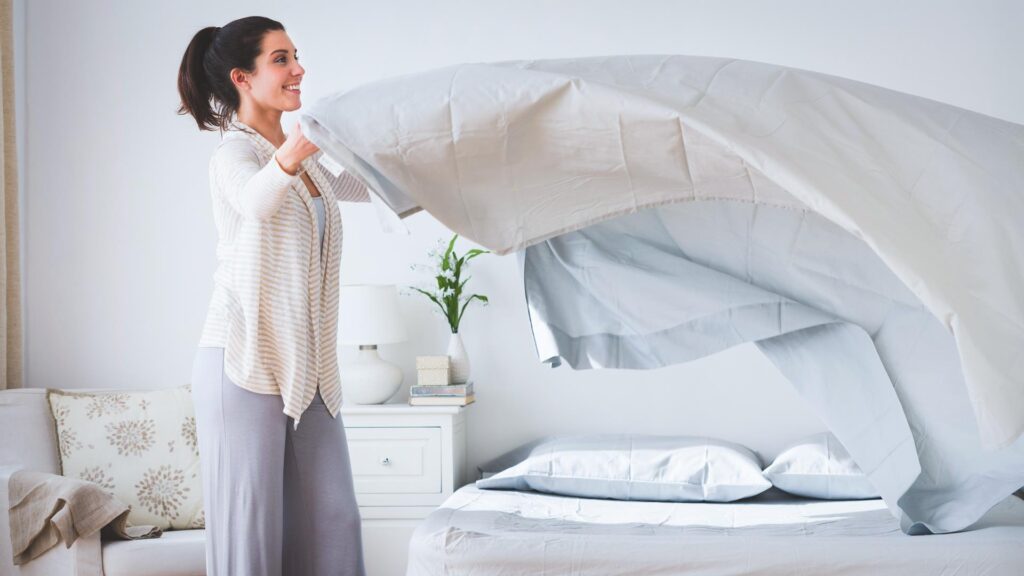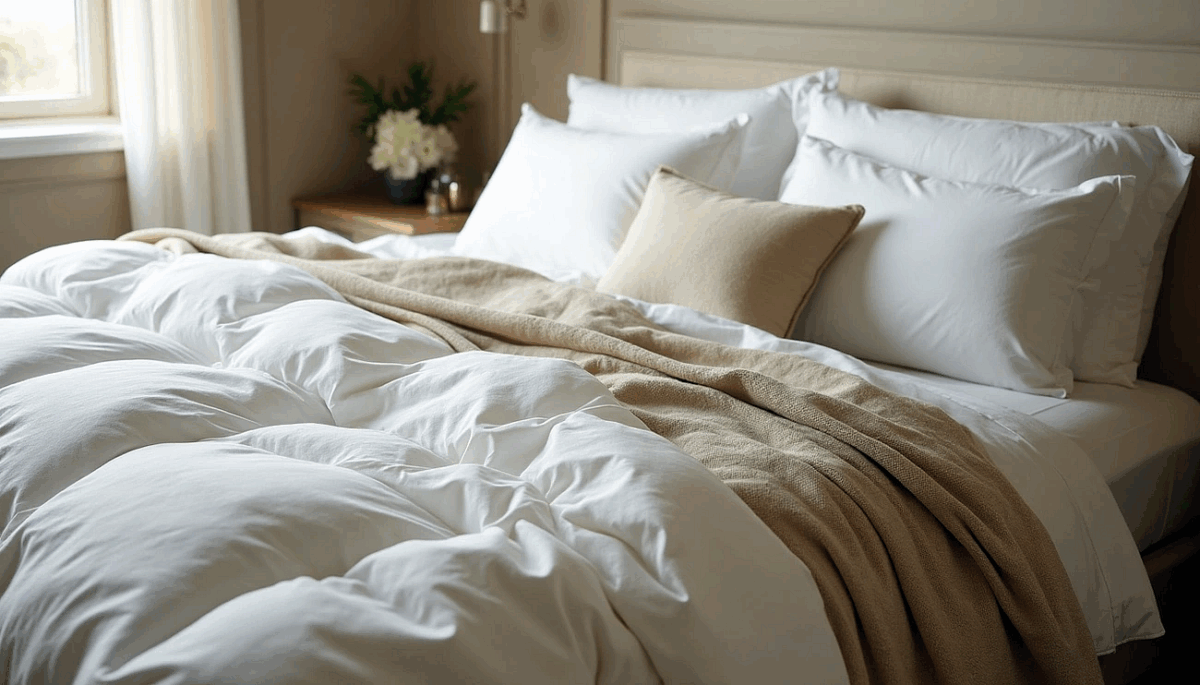Sleep Talk Blog, Health & Wellbeing
How to Choose Bedding Materials: A Sleep Expert's Guide to Comfort
Table of Contents
North American consumers spent over £11 billion on bedding in 2023 alone. These numbers show how much we value our sleep environment.
Choosing the right bedding materials can feel overwhelming with countless options available. Egyptian cotton stands out as the world's finest cotton for bed linen. Breathable linen and silky-smooth alternatives add to the mix. Quality bedding creates the perfect sleep sanctuary, so understanding its characteristics matters.
The best bedding might surprise you. Many people think higher thread counts mean better quality. The sweet spot actually ranges between 200 and 400. Fabrics with counts below 180 feel coarser. Numbers above 400 often mislead buyers because manufacturers use multi-ply thread to inflate the count.
This piece guides you through different bedding types and explains why certain materials work better for specific needs. You'll learn everything about weaves and practical aspects of bedding. Hot sleepers looking for breathable options or people with sensitive skin will find helpful solutions. Your bed deserves to become the cosy retreat you've always wanted!
Understanding Bedding Feel and Comfort
Why bedding feel matters for sleep
Your bedding's texture affects more than just luxury—it plays a crucial role in how well you sleep. Research shows that when sheets, pillows, or mattresses don't feel right, you'll toss and turn all night, which breaks up your sleep. Our bodies react strongly to how things feel when we rest.
Sleep and temperature regulation go hand in hand. Your body needs to stay at just the right temperature to sleep well, and your bedding affects this by a lot. Finding that sweet spot where you're not too hot or cold really helps you get quality sleep.
Research shows that the type of bedding materials and how your mattress is built can affect your sleep patterns and quality. The right mix can help you sleep deeper by making you more comfortable. Clean, fresh sheets on a well-made bed also help you feel relaxed and ready to drift off.
Smooth vs. crisp vs. cosy textures
You should pick between smooth and silky, cool and crisp, or cosy and warm bedding. This choice will help you select the right fabric and weave.
Percale gives you a crisp, cool feel with a matte finish. Hot sleepers love it, and it works great in warm weather because it lets air flow through easily. This weave uses a simple over-under pattern that makes the fabric look tight and closely woven.
Sateen feels soft and silky with a subtle shine. It uses a three-over-one-under weave that makes it warmer and heavier than percale—perfect for those chilly nights.
Brushed cotton creates a soft, slightly fluffy feel that's super cosy. While it still breathes well, it really shines during cold weather. Flannel also gives you that soft, plush, slightly fuzzy feeling that keeps heat in nicely.
How fabric impacts skin and temperature
Science validates the connection between bedding materials and sleep quality. What you wear to bed and sleep under affects how well you rest by controlling your skin temperature and comfort. Your body naturally cools down when you start to fall asleep, and the right bedding helps this process.
Different fibres work in unique ways:
- Cotton breathes well and wicks away moisture, making it a great choice for most people
- Linen keeps temperature steady and moves moisture away quickly, helping you sleep better when it's warm
- Wool lets more water vapour escape than cotton and polyester, so sweat evaporates faster
- Silk repels allergens and keeps temperature steady
Studies back these differences up. Wool pyjamas helped adults fall asleep faster in cool weather and worked well for older adults in warm conditions. Linen sheets improved how young adults slept in warm weather, while goose down duvets increased deep sleep when it was cool.
To stay comfortable in normal or warm weather, fabric needs to let water vapour pass through easily. This keeps sweat evaporating from your skin. That's why natural fibres are so good at keeping your body temperature steady all night long.
Learning About Bedding Materials and Fibres

Bedding materials come in many options. Each fabric type affects how well you sleep. The right choice can transform your nights from restless to peaceful.
Cotton: The all-rounder
Cotton stands as the most popular bedding fabric. People love it because it breathes well and wicks away moisture. This natural fibre comes in several types that each bring their own benefits.
Egyptian cotton tops the list of premium options. Its extra-long fibres grow in Egypt's special climate and soil. The plants grow bigger at a slower pace, which creates longer fibres and premium fabric. That's why real Egyptian cotton sheets feel so soft and let air flow through easily.
Pima cotton makes a great middle-ground choice and feels really soft. Upland cotton costs less but still works well. People who care about the environment often pick organic cotton. It needs nowhere near as much water and energy as regular cotton. Farmers grow it without man-made pesticides and fertilisers.
Cotton sheets get softer every time you wash them. They last a long time and stay comfortable. Taking care of them is simple - just throw them in the washer and dryer.
Linen: Breathable and durable
Linen comes from the flax plant and lasts a really long time. Unlike cotton, we measure linen by GSM (grammes per square metre) instead of thread count. Most linen bedding ranges from 140 to 220 GSM. Higher numbers show thicker fabric.
Linen's hollow fibres let air move freely, which helps control temperature naturally. The fabric can soak up 20% of its weight in moisture before feeling wet. This makes it perfect for people who get hot while sleeping.
New linen sheets feel a bit rough but become softer after several washes. This natural fibre proves much stronger than cotton - about three times as strong. Good care means your linen bedding could last for decades.
Silk: Luxurious and hypoallergenic
Silkworms create silk in their cocoons. This fabric brings luxury and health perks together. Dust mites can't live well on its smooth surface, which helps allergy sufferers. Silk's protein structure keeps common allergens away, including dust mites, mould, and mildew.
Silk does more than just help with allergies. It controls temperature well and moves moisture away from your body. The fabric's structure helps prevent mould and mildew by managing moisture and temperature.
You need to be careful with silk sheets. Wash them in cold water on delicate and let them air dry. Even with good care, silk might not last as long as other materials. That's the trade-off for getting such soft, smooth sheets.
Bamboo and eucalyptus: Eco-friendly options

Bamboo and eucalyptus fabrics have become popular green alternatives. Bamboo grows faster and doesn't need chemical pesticides or fertilisers like cotton does. Eucalyptus trees grow strong with less water and fewer pesticides than cotton.
Both materials go through the Lyocell process. Manufacturers grind the wood into pulp to create fibres. Many companies now use closed-loop systems. They reuse chemicals and water many times to make production more environmentally responsible.
These materials share great features. Both wick moisture well, breathe easily, feel soft, and fight bacteria. The main difference? Bamboo bounces back better and stretches more, while eucalyptus gets softer as you use it.
Microfibre and polyester: Budget-friendly choices
Microfibre and polyester sheets won't break the bank but still feel nice. Microfibre is a type of polyester with fine, tight fibres. Manufacturers brush it to make it feel soft and velvety. These synthetic materials resist wrinkles, clean up easily, and last quite a while.
These fabrics might not breathe as well as natural ones, but they shine in other ways. Microfibre stays light but tough thanks to its tight weave. Polyester resists stains, keeps its colour, and dries quickly after washing.
Some people want the best of both worlds. Polycotton blends mix cotton's softness with polyester's toughness and wrinkle resistance. These blends need less care than pure cotton and still let your skin breathe pretty well.
Weaves, Thread Count and Fabric Quality
The way your bedding is made plays a vital role in its comfort and durability. Learning about these technical details helps you shop smarter for quality sheets.
Percale vs. sateen vs. twill
The weave pattern changes how bedding feels on your skin. Percale's simple one-over-one-under pattern creates a crisp, matte finish that stays cool and light—perfect for summer months or hot sleepers. Sateen uses a one-under-three-over technique that shows more thread surface and gives a silky feel with a subtle sheen. This denser construction makes sateen a bit heavier and warmer than percale.
You'll spot twill by its distinctive diagonal pattern. It feels coarser but lasts longer. The looser yarn layout allows fabrics to bend easily with higher thread counts. This weave works great for bedding that gets heavy use because it's tough and resilient.
What is thread count and does it matter?
Thread count shows how many threads fit into one square inch of fabric. Don't fall for marketing hype about super-high numbers—they don't always mean better quality. Most experts say the sweet spot is 200-400 for cotton percale and 300-600 for sateen.
Watch out for thread counts over 800. Manufacturers often use tricks by counting multi-ply yarns as separate threads. Single-ply yarns usually create softer fabrics compared to multiple plies.
GSM and momme explained
Different materials need different ways to measure quality. Linen uses GSM (grammes per square metre), usually between 150-190 GSM. A higher GSM means you get a denser, heavier fabric—not better, just different.
Silk quality is measured in momme (pronounced "mom-ee"), where one momme equals 4.34 grammes per square metre. Quality silk bedding usually ranges from 17-22 momme, with 22-momme being the gold standard. More momme means more silk in each fabric area, which leads to better durability and richer colours.
How weave affects breathability and feel

The gaps between threads make a big difference in airflow and temperature control. Percale's basic construction creates small, even spaces that let air flow freely, making it very breathable. Sateen's tighter weave keeps more warmth in while fighting wrinkles better.
Each weave feels different too—percale stays crisp and light, sateen feels silky smooth, and twill gives you a durable, textured feel. Your perfect bedding choice depends on what you like and how you sleep, not just the highest numbers on a tag.
Choosing the Best Bedding for Your Needs
The perfect bedding choice ended up being about your individual sleep priorities and what you need. Everyone sleeps differently—what one person finds luxurious might feel uncomfortable to another.
Hot vs. cold sleepers
Hot sleepers should look for natural materials that breathe well. Cotton with a lower thread count (around 300) gives better airflow and helps wick away moisture. Linen makes another excellent choice because it lets air move freely while pulling moisture away from your body.
Cold sleepers need the opposite approach. Materials that keep heat in—like flannel, fleece, or higher thread count fabrics—create a warm and cosy sleep environment. Cotton sateen's tighter weave helps trap warm air. Wool bedding works great for cold sleepers because it insulates naturally while staying breathable.
Sensitive skin and allergies
Hypoallergenic materials are a must if you have sensitive skin or allergies. Bamboo stands out because it's naturally antibacterial and keeps dust mites away. Silk costs more but creates a smooth surface that reduces friction on irritated skin.
Organic cotton helps people with eczema and psoriasis by avoiding exposure to irritating chemicals and pesticides. Specially treated hollowfibre duvets that curb dust mites and bacteria are a great way to get relief for allergy sufferers.
Best bedding material for kids

Kids need different bedding than adults. Natural fibres like cotton and British wool should top your list as they're gentle on delicate skin and let air flow properly. Kids overheat more easily than adults, so lightweight, breathable options are vital.
Bedding with Oeko-Tex 100 certification makes sense for toddlers as it confirms no harmful toxins or chemicals were used in production. Kids with dust-mite allergies or asthma need bedding with No-mite accreditation.
Breathable bedding materials for summer
Natural fibres become especially important during summer months. Cotton and linen excel at moving moisture away and optimising airflow. Bamboo bedding offers an eco-friendly option with excellent temperature control and moisture-wicking properties.
Note that synthetic materials don't work well in warm weather. Microfibre and polyester trap heat and don't breathe, making them poor choices for summer use.
Style, Size and Practical Considerations
Your bedding's comfort and functionality depend on practical choices that go beyond material selection. These final details make sure your bedding feels amazing and matches your bedroom's look perfectly.
Picking the right size and fit
The right bed linen starts with your mattress size. A size mismatch can make sleeping uncomfortable. Your mattress depth determines the fitted sheet size you need. This ensures sheets stay tucked under each corner throughout the night.
Fitted sheets need more depth than your mattress. This extra fabric helps them stay secure underneath without bunching up. Deep pocket sheets work best with thick mattresses between 13-17 inches.
A slightly larger duvet cover creates a luxurious drape effect. Duvet covers usually extend past the mattress edges. Just don't go too big - your bed looks messy if the duvet touches the floor.
Plain or patterned: What suits your room?
The choice between plain and patterned bedding remains a classic dilemma. Hotels love white bedding, a trend that Westin made popular in the 1990s with their 'heavenly bed' look. White bedding suggests cleanliness and freshness through a 'halo effect'.
Plain bedding stays versatile and lasts longer. You can add decorative throws or cushions while your plain duvet cover remains timeless. Plain options sell better than patterns, especially since bedrooms became 'zen dens' during lockdown.
Patterned bedding adds character but follows fashion trends more closely. The right pattern brings together colours from your bedroom's decor.
Fastenings and pillowcase types
Bedding comes with buttons, poppers, hook and eyes, or no fastening at all. Your choice affects both looks and ease of changing.
Different pillowcase styles offer unique benefits:
- Housewife pillowcases cover pillows completely to stop creasing and sagging
- Oxford pillowcases have an elegant decorative frill around the edge
- Bag style pillowcases feature open ends you can tuck in, making changes quick and easy
Certifications and eco-labels to look for
The Oeko-Tex Standard 100 certification shows your bedding has safe levels of over 100 substances from 17 chemical groups. This certification matters even more for children's bedding.
GOTS (Global Organic Textile Standard) requires 95% certified organic materials. The remaining 5% must avoid certain substances. Sedex certification ensures ethical trade practises and clear supply chains.
Conclusion
The right bedding materials will reshape your sleep from ordinary to exceptional. This piece explores how different fibres affect comfort, temperature control, and sleep quality. Cotton gives you versatility and breathability. Linen delivers durability with great temperature control. Silk stands out with its luxurious feel and hypoallergenic properties that benefit people with sensitive skin.
Many people misunderstand thread count's role in bedding quality. The best counts range from 200-400 for cotton percale and 300-600 for sateen, not the high numbers you see in ads. Your priorities and sleeping habits should guide your choice above everything else.
Hot sleepers will love breathable materials like linen and percale cotton. Cold sleepers might prefer flannel or sateen that keep heat in. People with allergies or sensitive skin can get great benefits from hypoallergenic options like organic cotton, bamboo, or silk.
Your bedding needs the right size to stay in place at night. Style choices shape your bedroom's look and feel. Certifications like Oeko-Tex and GOTS show quality and environmental responsibility.
Perfect bedding creates a sleep environment that helps your body's natural processes. It boosts comfort and promotes better sleep. Think of bedding as an investment in your wellbeing. We spend about one-third of our lives in bed, which makes quality bedding one of our most important purchases for health and happiness.
Key Takeaways
Understanding bedding materials is crucial for creating the perfect sleep environment, as the right choice can significantly impact your comfort, temperature regulation, and overall sleep quality.
• Thread count isn't everything: Optimal thread counts range from 200-400 for cotton percale, not the inflated numbers often marketed—focus on weave and material quality instead.
• Match materials to your sleep style: Hot sleepers should choose breathable options like linen or percale cotton, whilst cold sleepers benefit from flannel or sateen weaves.
• Natural fibres excel at temperature regulation: Cotton, linen, and silk offer superior breathability and moisture-wicking compared to synthetic alternatives like polyester.
• Weave determines feel and function: Percale creates crisp, cool sheets perfect for summer, whilst sateen offers silky smoothness with more warmth retention.
• Consider your specific needs: Those with allergies should opt for hypoallergenic materials like bamboo or silk, whilst children benefit from gentle, breathable organic cotton.
The key to perfect bedding lies in matching material properties to your individual sleep preferences rather than simply choosing the most expensive option. Quality bedding is an investment in your wellbeing—after all, we spend a third of our lives in bed.

